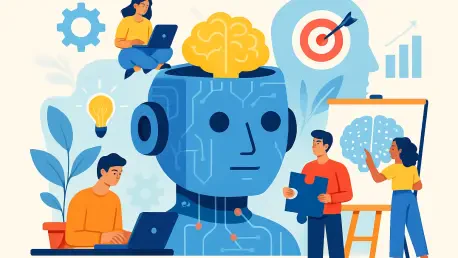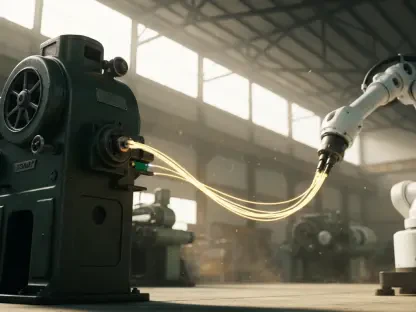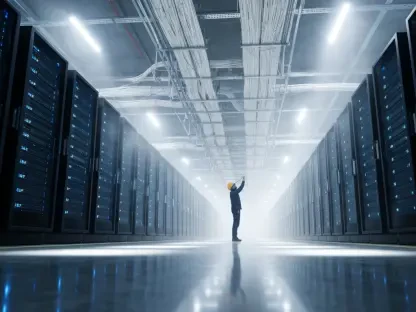Imagine a world where artificial intelligence not only streamlines mundane tasks but also amplifies the very essence of human creativity, transforming industries like media, fashion, and design at an unprecedented pace. This is the reality unfolding through the Centre for Creative AI, a pioneering collaboration between University College London, the Royal College of Art, and The Brandtech Group, slated to launch this fall. This initiative is set to revolutionize how talent is nurtured in a landscape increasingly dominated by AI, pushing beyond mere technological adoption to address the deeper challenge of equipping professionals with skills for a new era. The implications ripple across individual careers and entire organizations, reshaping competitive dynamics in a global creative economy. As AI integrates into every facet of business, from product design to marketing strategies, the urgency to adapt has never been greater. This transformative moment demands a rethinking of traditional approaches, setting the stage for a profound shift in how creativity and innovation are defined and harnessed.
The Impact of AI on the Creative Economy
AI as a Game-Changer
The integration of artificial intelligence into the creative economy marks a seismic shift, far beyond the incremental changes brought by past technologies like mobile apps or social media platforms. Described as a “horizontal technology” by Mark Eaves, founder of Gravity Road and a key figure in the Centre’s inception, AI permeates every layer of business operations—touching supply chains, product development, and customer engagement. This pervasive influence has sparked rapid awareness among top executives, with CEOs recognizing the need to pivot swiftly to harness AI’s potential. For HR leaders, this creates a dual challenge and opportunity: to align workforce capabilities with a technology that reshapes roles overnight. Unlike previous disruptions that unfolded over years, AI’s impact is immediate, demanding strategic foresight to integrate it effectively. The Centre stands as a response to this urgency, aiming to bridge the gap between technological innovation and human talent in a way that redefines industry standards.
This rapid transformation also signals a departure from viewing AI as merely a tool for efficiency. Instead, it’s a catalyst for reimagining the creative process itself, enabling novel approaches to storytelling, design, and brand interaction. Corporate leaders are increasingly aware that ignoring this wave risks obsolescence in a hyper-competitive market. The Centre’s mission to foster AI fluency among creative professionals addresses this head-on, ensuring that businesses can leverage the technology to innovate rather than react. HR departments, in particular, face pressure to anticipate skill needs rather than respond after the fact, positioning themselves as strategic partners in organizational growth. This shift underscores a broader trend: AI isn’t just about automation but about augmenting human ingenuity to achieve outcomes previously unimaginable, setting a new benchmark for what creativity can accomplish in a tech-driven world.
Breaking Down Silos
Historically, creative industries have operated within rigid silos, with professionals confined to specialized roles like graphic design or copywriting, rarely crossing into other domains. AI is dismantling these barriers, ushering in a demand for talent capable of orchestrating multiple elements across disciplines. This evolution challenges traditional recruitment models that prioritize narrow expertise, instead valuing adaptability and critical thinking as core competencies. As Mark Eaves notes, the modern creative professional must synthesize diverse inputs, blending technical, artistic, and strategic perspectives to produce impactful work. The Centre for Creative AI aims to cultivate this versatility, preparing individuals to navigate a landscape where boundaries between roles blur. For organizations, this means rethinking team structures to foster collaboration across previously separate functions, ensuring they remain agile in a fast-evolving market.
This breakdown of silos also necessitates a cultural shift within companies, moving away from compartmentalized thinking toward integrated, cross-functional approaches. HR leaders play a crucial role in facilitating this transition, identifying candidates who demonstrate learning agility and the ability to pivot between tasks. The emphasis is less on mastering specific tools—since AI technologies evolve rapidly—and more on meta-skills like problem-solving and interdisciplinary collaboration. By championing such qualities, businesses can build resilient workforces ready to tackle complex challenges AI introduces. The Centre’s focus on nurturing these attributes offers a blueprint for industries worldwide, highlighting that success in an AI-driven economy hinges on flexibility rather than rigid specialization. This redefinition of talent underscores a fundamental truth: the future belongs to those who can adapt and innovate across traditional boundaries, reshaping how creative value is created and delivered.
Talent Development for an AI-Augmented Future
Generational Dynamics in AI Adoption
A striking aspect of AI’s integration into the creative sector is the generational divide in its adoption and application, with younger professionals often leading the charge in innovative uses. As Valentina Culatti, global director of creative strategy at Snap, points out, emerging talent isn’t just adapting to AI but actively shaping its role in creative contexts, from ideation to execution. This innate fluency positions them as drivers of change, bringing fresh perspectives that challenge conventional workflows. However, this also highlights a critical need for organizations to upskill existing employees, ensuring that seasoned professionals aren’t left behind in the rush toward technological advancement. Balancing the energy of youth with the experience of veteran staff becomes a delicate but essential task. The Centre for Creative AI addresses this by creating programs that engage both groups, fostering an environment where knowledge transfer and innovation coexist to strengthen overall workforce capability.
The risk of a widening skills gap looms large if companies fail to address this generational dynamic thoughtfully. While younger workers may intuitively grasp AI tools, older employees bring contextual understanding and industry insight that are equally vital for meaningful application. Training initiatives must therefore be inclusive, tailored to varying levels of tech familiarity while emphasizing shared goals like creativity and collaboration. The Centre’s approach serves as a model, promoting mentorship and peer learning to bridge generational divides. By doing so, it ensures that organizations don’t just chase the latest trends but build sustainable talent pipelines that leverage diverse strengths. This balance is crucial for maintaining cohesion in teams navigating AI’s disruptive potential, allowing businesses to innovate without sacrificing the depth of experience that anchors long-term success in competitive creative markets.
A New Paradigm in Skill Building
The Centre for Creative AI embodies a forward-thinking approach to talent development by uniting technologists, artists, and business leaders in a collaborative framework that mirrors the interdisciplinary nature of modern creative work. This cross-functional model challenges outdated educational and training methods that often isolate disciplines, instead promoting a holistic understanding of how AI intersects with various fields. By bringing together diverse expertise, the initiative ensures that emerging professionals gain exposure to real-world applications of AI, from conceptual design to strategic implementation. Learning agility becomes a cornerstone of this paradigm, as individuals must continuously adapt to tools and platforms that evolve at a breakneck pace. This focus on adaptability prepares talent not just for today’s challenges but for the unforeseen shifts that lie ahead in an AI-centric economy.
Structured experimentation also plays a pivotal role in this new paradigm, offering safe spaces where creative teams can explore AI’s possibilities without the immediate pressure of commercial outcomes. Such environments encourage risk-taking and innovation, allowing professionals to test boundaries and discover novel applications that might otherwise be overlooked. The Centre champions this exploratory mindset, recognizing that true mastery of AI comes from hands-on experience rather than theoretical knowledge alone. For HR leaders, this signals a need to integrate similar opportunities into corporate training programs, prioritizing curiosity and iterative learning over rigid performance metrics. By fostering a culture of experimentation, organizations can unlock AI’s full potential, ensuring their workforce remains at the forefront of a rapidly changing creative landscape where innovation is the ultimate currency.
Strategic Imperatives for Organizations
Corporate Involvement and Competitive Edge
The backing of the Centre for Creative AI by major corporations like Diageo, Unilever, and Snap underscores a growing recognition that AI integration is not a luxury but a strategic imperative for maintaining market relevance. As Esi Eggleston Bracey, Unilever’s chief growth and marketing officer, articulates, AI serves as a catalyst for reimagining creativity itself, pushing companies to rethink how they connect with audiences and develop products. This corporate involvement signals a broader trend: businesses must proactively embed AI into their creative strategies to stay competitive, especially in export-driven markets like the U.K.’s creative sector. The Centre’s partnership model offers a glimpse into how industry leaders are aligning with academic innovation to address workforce transformation, ensuring they don’t just keep pace with global rivals but set the standard for what’s possible in an AI-enhanced economy.
This strategic focus on AI also reflects a deeper understanding that creativity and productivity are intertwined in the modern marketplace. Companies that fail to invest in AI-driven talent development risk losing ground to competitors who can innovate faster and more effectively. The Centre’s collaborative framework provides a roadmap for such investment, demonstrating how corporate-academic alliances can yield practical solutions to complex challenges. For global firms, this is particularly critical in industries where differentiation through creative output drives consumer loyalty and revenue. By prioritizing AI fluency, organizations position themselves to capitalize on emerging opportunities, from personalized marketing to cutting-edge design, ensuring they remain leaders rather than followers in a landscape where technological prowess increasingly defines success.
HR’s Pivotal Role in Transformation
HR leaders stand at the forefront of navigating the AI-driven transformation, tasked with dismantling internal silos and fostering cross-disciplinary collaboration within their organizations. This role extends beyond traditional recruitment to shaping environments where diverse teams can thrive, blending technical and creative skills to tackle multifaceted challenges. By championing initiatives that mirror the Centre for Creative AI’s interdisciplinary ethos, HR professionals help build workforces capable of leveraging AI as a partner rather than a threat. This involves curating training programs that emphasize adaptability, ensuring employees across all levels can engage with evolving technologies. The focus shifts from filling roles to cultivating a culture of continuous learning, where collaboration across departments becomes the norm rather than the exception, driving innovation at every turn.
Equally critical is HR’s responsibility to create safe spaces for AI experimentation, where teams can explore the technology’s potential without fear of immediate failure or commercial backlash. This approach, inspired by the Centre’s emphasis on structured exploration, allows organizations to uncover unique applications that enhance creative output. Moreover, HR must prioritize human-centric skills like judgment and critical thinking, which remain irreplaceable even as AI automates routine tasks. These qualities ensure that technology serves as an enabler of human vision rather than a replacement for it. By embedding such values into talent strategies, HR leaders not only prepare their organizations for current disruptions but also lay the groundwork for resilience against future shifts, ensuring that human ingenuity remains the heart of creativity in an increasingly automated world.
Reflecting on a Transformative Journey
Looking back, the launch of the Centre for Creative AI marked a defining moment in the creative economy, setting a precedent for how academia and industry could unite to address the challenges of an AI-driven world. Its collaborative model proved instrumental in reshaping talent development, demonstrating that adaptability and cross-disciplinary skills were non-negotiable for success. HR leaders who embraced this vision found themselves better equipped to steer their organizations through rapid technological change, while corporate backing from global giants validated the strategic importance of AI integration. Moving forward, the lessons from this initiative suggest a clear path: invest in structured experimentation, prioritize human-centric competencies, and foster inclusive training that bridges generational gaps. These steps will empower businesses to not only navigate the current landscape but also anticipate future innovations, ensuring that creativity and technology continue to evolve hand in hand.









